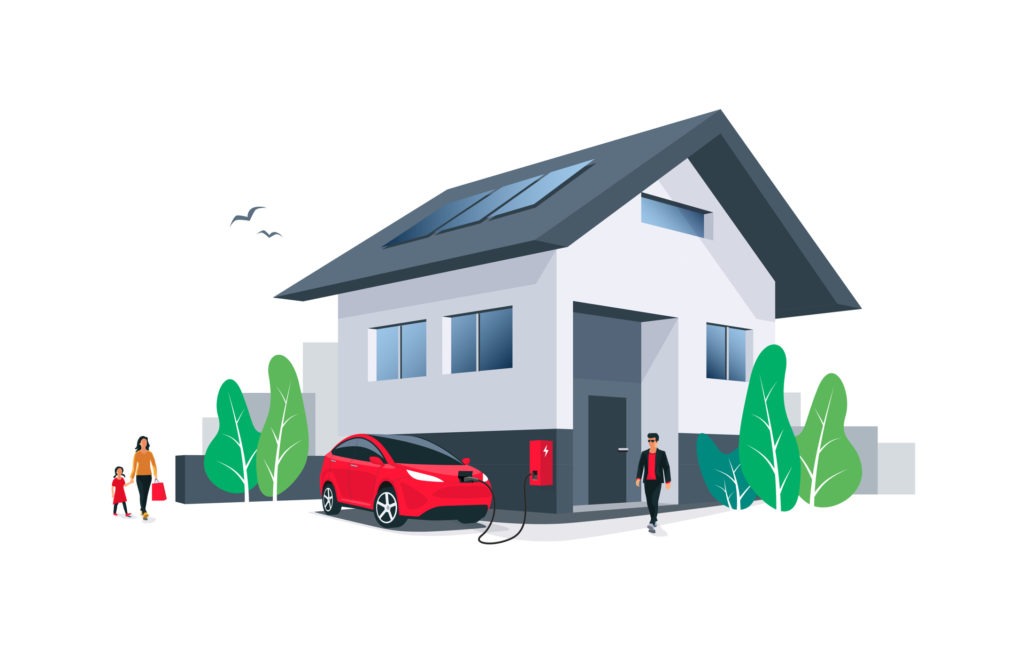How to boost private EV charging infrastructure with connected thinking
29 July 2022

Not all automotive companies are approaching private electric-vehicle (EV) infrastructure the same way. Autovista24 deputy editor Tom Geggus considers more connected charging solutions.
Alongside Eurelectric, Ernst & Young (EY) calculates that 130 million EVs will hit Europe’s roads by 2035, requiring at least 65 million chargers. The pair predict that nine million will be public, while 56 million will be residential. This illustrates how infrastructure installation will be determined by different driver-usage scenarios.
While public plugs are essential for households without off-street parking, EY and its commentators agree the most convenient, cheapest, and preferred location to charge is at home. A study from the UK National Audit Office found that domestic charging is 59% to 78% cheaper than public charging.
As Europe’s EV adoption continues to gain speed, infrastructure providers will need to stand out in what will become a highly valuable and competitive market. This means thinking outside the wallbox, connecting EV infrastructure to additional systems and services.
All-in-one solution

After six years of driving EVs, 350,000km worth of electric journeys, and over 25 years in grid management, Laurent Schmitt CEO of dcbel Europe, understands the importance of connected charging infrastructure. Founded in 2015, the company is building an all-in-one home energy station, which is to debut in California in the next couple of months. A UK launch is expected to follow in October, thanks to its mature photovoltaic (PV) market and dynamic energy tariffs.
Known as the r16, dcbel’s all-in-one station looks to become a bridge between two electric worlds. On one side, home energy systems with access to renewable sources, namely PVs, and on the other, EV charging infrastructure. Joining the two with bi-directional technology means electric vehicles can become more than just consumers of electricity, instead transforming into an integral part of the home power system. Schmitt outlined an expectation for bi-directional systems to become a mainstream option by 2025.
‘If you look at the latest regulatory move from Ofgem [the UK’s energy regulator], you can now use the metering device of your charger to manage its flexibility independently from the rest of the house. So potentially, you can use a combination of dynamic and flat tariffs in your home energy environment,’ Schmitt told Autovista24.
Dcbel examined the development of photovoltaic technology and flexible energy rates across Europe. While France’s PV market growth looks good, it lacks substantial flexible tariff regulation. Italy’s EV market development is not ideal, while both Spain’s PV and energy regulations are lagging. Elsewhere, Germany and Austria operate high-power three-phase electricity connections into the home, whereas the UK uses small-load one-phase technology up to 12kW.
At the end of June, the UK also mandated that infrastructure installed at homes and workplaces must support smart charging. This should mean greater grid demand management, while also encouraging EV drivers to opt for smarter tariffs. But beyond using mandates as the UK has done, Schmitt considers educating drivers to be a necessity. This includes illustrating how connected EV infrastructure can save people money through optimised charging times.
A bridge between worlds
For many, vehicle-to-home (V2H) solutions, which do not export energy to the grid, can be seen as a precursor to vehicle-to-grid (V2G) charging. This more expansive technology faces the question of charger cost. However, Schmitt explained that because dcbel’s charger contains multiple functions including PV management capabilities, the associated extra costs can be amortised. ‘Once you have the V2H it is virtually free to provide V2G services in a way because you have already amortised the CAPEX. So, we see V2G as providing an extra revenue stream,’ he said.
As power prices peak, Schmitt calculates that a consumer installing a PV-equipped, bi-directional dcbel system, could see a return on investment (ROI) in less than five years. ‘I think we can really be sure that it is a very good ROI. It makes sense especially when you have an EV that you can charge during solar peak hours,’ Schmitt said.
With dcbel’s system, an EV and an optional additional battery unit can store PV power during peak times, maximising sustainable energy, and lowering demand on the wider network. ‘The complexity is really about finding the best time to schedule your charging,’ Schmitt said. Automating this task allows for the juggling of multiple criteria.
‘One criteria is maximising the use of your PV, but also looking at your agreed energy tariffs which we think will become more and more dynamic, when it comes to charging,’ Schmitt said. ‘That means you have a constant equation to look at, which is running a real-time home energy optimisation.’
Control is key
At the heart of smart charging is the potential for greater control. Users get a better grasp on cost, but also, sustainability. For those concerned about their carbon footprints, there is the option to utilise grid energy when it is generated by via renewable sources. Then, local PV power can be drawn from when fossil fuels come back into the grid’s mix. ‘The flexibility of this charging system is such that you can pick the hours when you have access to renewable energy, that is really fantastic,’ the CEO said.
But dcbel wants to avoid burdening users with making manual changes to avoid unsustainable or costly energy. Instead, the optimised system uses live intelligence to make the switch automatically, although this can be turned off if rapid EV charging is required. ‘First of all, it must be extremely simple for the user, it must be transparent in the way he or she uses the cars,’ Schmitt explained. ‘You want to have metrics and data on the charging cost savings and carbon reduction benefits that your technology delivers.’
So connected charging capabilities give individual consumers access to a more advanced electric world. While fleets will also gain access to this type of technology, their relationship with infrastructure can be more complex and requires a different kind of joined up thinking.
Electrification-as-a-Service

Transitioning to an electric fleet is no simple task for a company. Electromobility is an entirely new world with different requirements, and charging points are high on the priority list. But what if electrification, including the introduction of infrastructure, could all be handled through one end-to-end service?
The pre-launch of the ID.3 in 2018 carried with it enormous importance for Volkswagen (VW). Not only was it the introduction of a new model but represented the arrival of the Modular Electric Platform (MEB), the foundation of the ID. family. The carmaker saw the need for greater market awareness of all-electric vehicles and so began a fresh consulting approach for fleet customers across Europe. Then in 2021, Volkswagen Financial Services (VWFS), VW Group’s mobility and financial arm, changed its focus from generating awareness to offering a more connected service.
‘So last year, we decided to step forward with our Electrification-as-a-Service (EaaS),’ Jochen Schmitz, director of international fleet at Volkswagen Financial Services (VWFS) told Autovista24. ‘Why? Because we found out in this big VW Group and VW family, we have a lot of experts doing bits and pieces in this electromobility area, and there is a big USP in combining all these offerings in front of our customers.’
What followed was a process of assessing which offerings could be combined, and where. ‘We are not talking anymore about creating awareness. We are now bringing an end-to-end solution with this model we have integrated into our EaaS approach,’ Schmitz added.
Modular makeup
Offering every element of electrification to fleets is an impressive show of reach, but not all businesses require every solution. Some fleets might have already begun their electric journey, or only need certain solutions. Therefore, EaaS is built as a modular, customisable service, so customers can get access to what they actually need. ‘It is the reality, especially in the fleet industry, that there is no one size fits all. Every customer is totally different,’ Schmitz said
The need for flexibility is particularly important when it comes to charging points. Geography is an foundational factor for EaaS, with Elli being VW Group’s preferred infrastructure partner. The company provides private infrastructure solutions for the workplace and the home. ‘Elli can also precisely separate the tariffs between private and commercial use,’ Schmitz explained. ‘This is particularly important for the customers and everyday fleet life.’
However, this offering is not available in all countries. This is where MHP, a Porsche consulting company, evaluates the best options for the customer in their given location, even establishing workarounds if necessary. With international fleets, this can mean creating a unique solution from different providers in each market.
EaaS also considers the total cost of ownership (TCO), a vital consideration point when electrifying a fleet. This means the customer receives all the necessary leasing rates including charging costs. Data about infrastructure use then comes down to each market provider, with some countries relying on a charging card while others have access to connected cable technology. By offering flexible infrastructure solutions, EaaS will be able to provide more fleets with the solutions they need, rather than a rigid package deal which misses the mark.
Joined up thinking, whether part of a V2H system or an electrification service, is defining infrastructure offerings for both consumers and companies. But how is regulation helping shape private charging points? Find out in an upcoming Autovista24 article.



